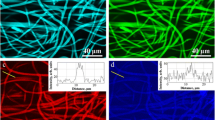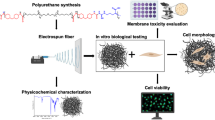Abstract
Polymeric biomaterials are used in tissue repair due to characteristics as biocompatibility and cell interaction. In the category of synthetic polymers, poly lactic acid (PLA) is especially used in several clinical applications. This biomaterial can be prepared in the form of dense and porous membranes, in order to characterize the interaction with Vero cells in culture, using scanning electron microscopy (SEM). For this purpose, dense and porous PLA membranes were previously prepared, sterilized by ultraviolet light (UV) and used as a substrate for cultivation of Vero cells, for periods of 2 h and 7 days. To observe the cell interaction with the membranes, different methodologies for processing the samples for observation by SEM were considered, and a comparative analysis of the results was performed. There was no significant difference in cell morphology comparing samples with and without osmium tetroxide, however samples that underwent drying at a critical point had better preservation of cell morphology compared to samples in chemical drying. Osmium tetroxide is not a major factor in the processing of cells for SEM, and that the type of drying is the factor that most affects cell morphology in this process. It was possible to observe cell adhesion after 2 h of culture, with morphological changes such as cytoplasmic transition to a more flat aspect being more characteristic for 7 days of culture.
Access this chapter
Tax calculation will be finalised at checkout
Purchases are for personal use only
Similar content being viewed by others
References
Williams DF (1987) Definition in biomaterials, consensus conference ESB
Langer R, Vacanti JP (1993) Tissue engineering. Science 260:920–926
Barbanti SH, Zavalia CAC (2005) Polímeros bioreabsorvíveis na engenharia de tecidos. Polímeros: Ciência e Tecnologia 15:13–21
Oliveira CS, Nascimento M, Junior EA et al (2010) Avanços e aplicações da bioengenharia tecidual. Ciências Médicas e Biológicas 9:28–36
Jahno, VD, Ligabue R, Einloft, S, Ribeiro, GBM et al (2006) Síntese e caracterização do poli(ácido l-láctico) e sua avaliação em culturas de osteoblastos humanos. Cong Bras Eng Ciênc Mat 7837–7847
Vert M, Li SM, Spenlehauer G, Guerin P (1992) Bioresorbability and biocompatibility of aliphatic polyesters. J Mater Sci Mater Med 3:432–446
Danisovic L, Varga I, Zamborsky R, Böhmer D (2012) The tissue engineering of articular cartilage: cells, scaffolds and stimulating factors. Exp Bio Med 237:10–17
Jafari M, Paknejad Z, Rad MR et al (2017) Polymeric scaffolds in tissue engineering: a literature review. J Biomed Mater Res B Appl Biomater 105:431–459
International Standarts Organization. ISO 10993-5 (2009b) Biological evaluation of medical devices—Part 5: tests for in vitro cytotoxicity, p 34
Dewez JL, Lhoest JB, Detrait E et al (1998) Adhesion of mammalian cells to polymer surfaces: from physical chemistry of surfaces to selective adhesion on defined patterns. Biomaterials 19:1441–1445
Wang X, Lou T, Zhao W et al (2016) The effect of fiber size and pore size on cell proliferation and infiltration in PLA scaffolds on bone tissue engineering. J Biomater Appl 30:1545–1551
Zeltinger J, Sherwood JK, Graham DA et al (2004) Effect of pore size and void fraction on cellular adhesion, proliferation, and matrix deposition. Tissue Eng 7:557–572
Lombello CB, Malmonge SM, Wada ML (2000) Morphology of fibroblastic cells cultured on poly (HEMA-co-AA) substrates. Cytobios 101:115–122
Santos Jr AR, Wada MLF (2007) Polímeros Biorreabsorvíveis como Substrato para Cultura de Células e Engenharia Tecidual. Polímeros: Ciênc Tecnol 17:308–317
Ammerman NC, Beier-Sexton M, Aad AF (2008) Growth and maintenance of Vero cell lines. Curr Prot Microb 11:4E:A.4E.1–A.4E.7
Nascimento MHM, Ferreira M, Malmonge SM, Lombello CB (2017) Evaluation of cell interaction with polymeric biomaterials based on hyaluronic acid and chitosan. J Mater Sci Mater Med 28(5)
Zhu WJ (2018) Preparation and observation methods can produce misleading artefacts in human sperm ultrastructural morphology. Andrologia e13043. https://doi.org/10.1111/and.13043
Impe J, Smet C, Tiwari B et al (2018) State of the art of nonthermal and thermal processing for inactivation of micro-organisms. J Appl Microbiol 125:16–35
Nascimento, MHM, Lombello CB. (2016) Hidrogéis a base de ácido hialurônico e quitosana para engenharia de tecido cartilaginoso. Polímeros: Ciênc Tecnol 26:360–370
Ferraraz DC, Tatsui NH, Rodrigues LR, Lombello CB (2019) Platelet-rich plasma as supplement and scaffold for the culture of Vero cell line. Res Biomed Eng 35:1–9
Zhang W, Soffe R, Nahavandi S, Shukla R, Khoshmanesh K (2014) High resolution scanning electron microscopy of cells using dielectrophoresis. PLoS ONE 9(8):
Amaducci MRL (2007) Efeitos do campo eletromagnético em células e bactérias. Dissertação(mestrado), UNICAMP, Campinas, SP, p. 102
Wisse E, Braet F, Duimel H, Vreuls C et al (2010) Fixation methods for electron microscopy of human and other liver. World J Gastroenterol 16:2851–2866
Barth OM, Silva MAN, Barreto-Vieira DF (2016) Low impact to fixed cell processing aiming transmission electron microscopy. Mem Inst Oswaldo Cruz 111:411–413
Carr J, Anderson R, Favero M (1996) Comparison of chemical dehydration and critical point drying for the stabilization and visualization of aging biofilm present on interior surfaces of PVC distribution pipe. J App Bacteriol 80:225–232
Barbieri DM, Fernandes T, Capelo O et al (2016) Método rápido, de baixo custo e reprodutível para secagem de biofilme bacteriano analisado em MEV. II Cong Paran Microbiol, Londrina
Glauert AM (1975) Practical methods in electron microscopy. Vol III: fixation, dehydration and embedding of biological specimens. North-Holland Publishing Company, pp 1–207
Lombello CB. (2018) Capítulo 6: Microscopia eletrônica para biologia celular. In: Santos Jr AR, Lombello CB (eds) Biologia celular: uma abordagem prática do ensino. EduFABC
Heckman C, Kanagasundaram S, Cayer M, Paige J (2007) Preparation of cultured cells for scanning electron microscope. Center for Microscopy and Microanalysis. Protocol Exchange. https://doi.org/10.1038/nprot.2007.504
Bray D (2000) Critical point drying of biological specimens for scanning electron microscopy. In: Williams JR, Clifford AA (eds) Supercritical fluid methods and protocols. methods in biotechnologyTM, vol 13. Humana Press
Thevenot P, Tang L, HU W (2008) Curr Top Med Chem 8:270–280
Muscariello L, Rosso F, Marino G et al (2005) A critical overview of ESEM applications in the biological field. J Cell Physiol 205:328–334
Acknowledgements
We thank the UFABC for the research development structure and the Multiuser Centers (CEM-UAFBC), for the samples preparation and SEM analysis.
Conflict of Interest
The authors declare that they have no conflict of interest.
Author information
Authors and Affiliations
Editor information
Editors and Affiliations
Rights and permissions
Copyright information
© 2022 Springer Nature Switzerland AG
About this paper
Cite this paper
Mazzaron, L.H.S., Lombello, C.B. (2022). Cellular Interaction with PLA Biomaterial: Scanning Electron Microscopy Analysis. In: Bastos-Filho, T.F., de Oliveira Caldeira, E.M., Frizera-Neto, A. (eds) XXVII Brazilian Congress on Biomedical Engineering. CBEB 2020. IFMBE Proceedings, vol 83. Springer, Cham. https://doi.org/10.1007/978-3-030-70601-2_24
Download citation
DOI: https://doi.org/10.1007/978-3-030-70601-2_24
Published:
Publisher Name: Springer, Cham
Print ISBN: 978-3-030-70600-5
Online ISBN: 978-3-030-70601-2
eBook Packages: EngineeringEngineering (R0)




